What is the RTMC?
The new Regional Transportation Management Center, also known as the RTMC, is a 44,700-square-foot, hurricane-ready facility that serves as the nerve center for traffic management across the nine counties that comprise FDOT’s District Five.
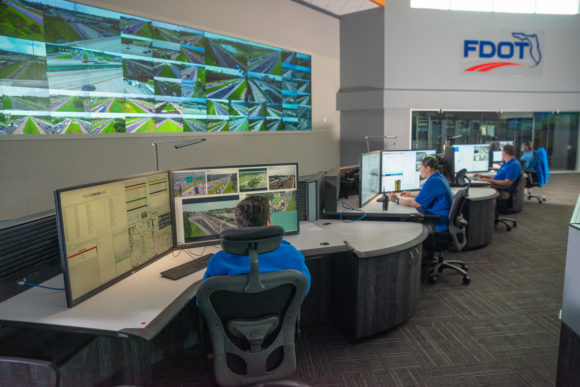
The new RTMC uses state-of-the-art technology to help operators stay ahead of traffic.
The RTMC monitors traffic, and it coordinates responses to incidents and crashes on Central Florida’s roughly 800 miles of highways and state roads. That includes Central Florida’s interstate highways – Interstate 4 (I-4), I-75, and I-95.
More than 100 traffic managers and other staffers work at the headquarters in Seminole County. They monitor highways and roads with the help of hundreds of highway camera feeds, thousands of live data streams from roadway sensors and ongoing communications with first responders. The Florida Highway Patrol dispatch center is also located in the RTMC.
The RTMC operates 24/7.
How Does the RTMC Help Minimize Congestion?
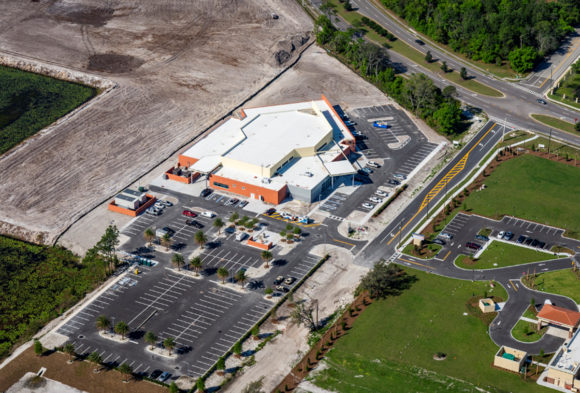
Construction on the new RTMC completed in 2019.
At the heart of the RTMC are the operators who monitor traffic conditions from their computer workstations in the control center.
When a crash or other incident occurs, the RTMC quickly dispatches Road Rangers and communicates with police, firefighters, and medical responders. Managers also send alerts to overhead roadway signs, news outlets and social media platforms, and they may activate temporary signal timing plans on nearby traffic signals. This process also helps minimize secondary crashes.
RTMC staff also actively manage arterial roads—important, continuous routes that accommodate high traffic volumes and speeds. In addition, they develop timing plans for day-to-day operations and special events.
Here’s a map of the roadways that the RTMC manages.
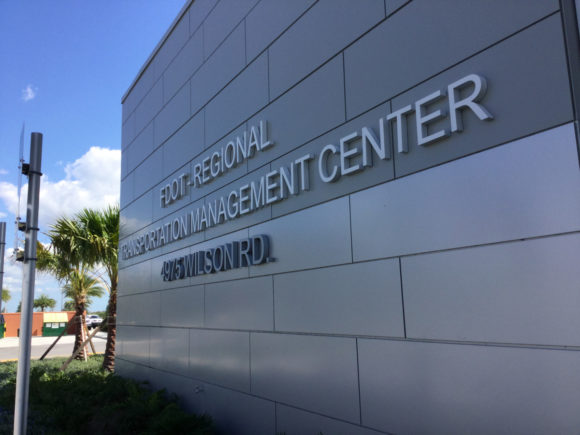
The new RTMC is located just off I-4 in Seminole County.
In an emergency…
The RTMC can function as an emergency response center when major storms, flooding, or wildfires hit the area. It is built to withstand a Category 3 hurricane.
Ready for the future…
The RTMC’s technology is designed to help set pricing for dynamic tolling on I-4 Express and to accommodate the expected arrival of connected and autonomous vehicles.
More RTMC info
How the RTMC Uses Data to Keep People Informed
Drivers often learn about congestion, construction, and crashes through driving apps, news sites, TV, and radio reports. Much of that information comes from the FDOT’s Regional Transportation Management Center (RTMC).
FDOT’s Intelligent Transportation Systems (ITS) program helps the department manage traffic by collecting data. The data is analyzed at the RTMC, where it is shared with drivers to help them safely and efficiently reach their destination.
Florida’s ITS includes:

Operators monitor traffic 24/7 in the control center.
- Roadside technology, including video cameras and vehicle detectors used to monitor the speed and volume of traffic; they also detect incidents, crashes, and congestion.
- Software to help operators to understand what’s happening on the roadways.
- Communication tools, including Florida 511, overhead message boards, connected vehicle applications, and truck parking availability systems that let drivers know about roadway conditions and alternative routes.
- Smart traffic control systems, such as intelligent traffic signals, ramp meters, variable toll systems, and transit priority systems, to help manage traffic flow.
- A network of fiber-optic and wireless connections that keep ITS data flowing from the roadside to the RTMC and back out to the drivers.
- The RTMCs and the engineers, operators, Road Rangers, first responders, and others who help keep Florida roadways moving safely and efficiently.
State-of-the-art Technology
Current conditions on freeways and other major roadways are shown on the 84 monitors lining the walls of the RTMC. 42 computer workstations display data about traffic speeds and volume, crash locations, Road Ranger vehicles, and more.
The backbone of Florida’s ITS network consists of miles of fiber optic cable buried along the state’s roads, which connects a vast array of roadside devices to the RTMC.
Those roadside devices include:
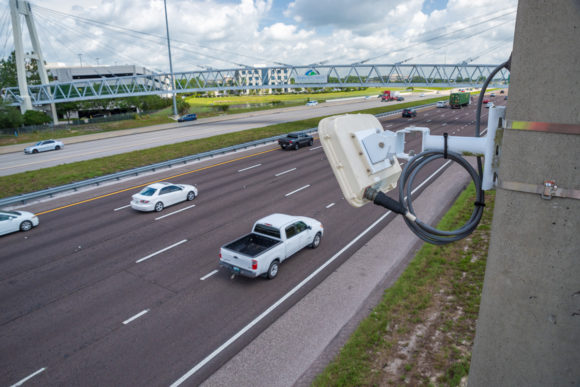
Traffic sensors detect slowdowns, which could indicate an incident has taken place on the roadway.
- Video cameras: FDOT District Five and partner agencies have more than 1,000 video cameras installed along freeways and state highways that feed high-resolution video to RTMC operators. The video is available to the public on FL511.com, and many TV news stations use the cameras for their on-air traffic reports.
- Traffic sensors: Nearly 400 sensors use microwave or radar technology to determine the current speed and volume of traffic on monitored roadways. This helps detect slowdowns that can indicate incidents.
- Control boxes: Protective boxes mounted on or near ITS equipment poles house the communication technology that keeps ITS devices connected, plus battery backups for power during outages.
- Dynamic message signs: Overhead digital signs display travel times and warn of incidents ahead. They also communicate safety messages and alerts.
ITS overview
ITS devices
Minimizing Traffic Without Construction
Beyond building and maintaining roadways, transportation agencies must also be strategic in how they get the most efficiency out of those roadways.
Transportation Systems Management and Operations (TSM&O) is the engineering discipline that finds ways to reduce congestion and improve safety without building more roads.
FDOT deploys several TSM&O strategies to help Florida residents, visitors, and commercial vehicle operators experience improved safety and mobility.

Intelligent Transportation Systems (ITS)
FDOT uses real-time information about traffic and roadway conditions to improve the safety and mobility of people, goods, and services. One of the most visible ITS programs is the state’s 511 Traveler Information System and the advanced technology and communication network that powers it.
Connected Vehicles
FDOT is deploying leading-edge technology to quickly identify roadway hazards and alert drivers. This builds upon the existing ITS program, which can identify the issues, and adds new technology that can communicate that information directly to vehicles to alert other drivers and first responders.
Managed Lanes
FDOT is building and operating managed lanes in some of the most congested parts of the state. These lanes provide drivers with the option to pay a toll to avoid congestion, which also helps improve traffic flow in the general-use (nontolled) lanes.
Statewide Arterial Management Program (STAMP)
Arterial roadways are state highways that are not freeways (like interstates) or toll roads. These roads present different challenges than freeways, such as intersections, traffic signals, the presence of pedestrians and bicyclists, and transit. In partnership with cities and counties, FDOT’s STAMP looks at ways to improve traffic flow and safety on arterial roadways (especially for bicyclists and pedestrians).
Regional Integrated Corridor Management System (R-ICMS)
FDOT combines freeway management and arterial management to improve mobility and safety for the entire state roadway system. R-ICMS includes ways to improve traffic on arterials when an incident or construction on a freeway causes more congestion on those roadways.
More TSM&O info
Incident Management
Crashes, disabled vehicles, and other roadway incidents cause nearly 25 percent of nonrecurring traffic congestion in the U.S., according to the Federal Highway Administration.
And when traffic starts to back up from an incident, it increases the likelihood of a secondary crash.
To help break this cycle, the Florida Department of Transportation (FDOT) and Florida Highway Patrol (FHP) work together with local law enforcement to clear incidents as quickly and safely as possible through the Traffic Incident Management (TIM) program.
As part of the TIM program, FDOT’s Regional Transportation Management Center (RTMC) performs incident detection and communicates with first responders.
RTMC operators use intelligent transportation systems technology, including roadway sensors and video cameras, to detect slowdowns caused by incidents.
Operators communicate with Road Rangers and FHP dispatchers to ensure a quick response. They also communicate incident information to drivers by posting alerts on overhead message boards and the state’s 511 system.
To learn more about TIM in Central Florida, visit www.cfltim.com.
Emergency Management
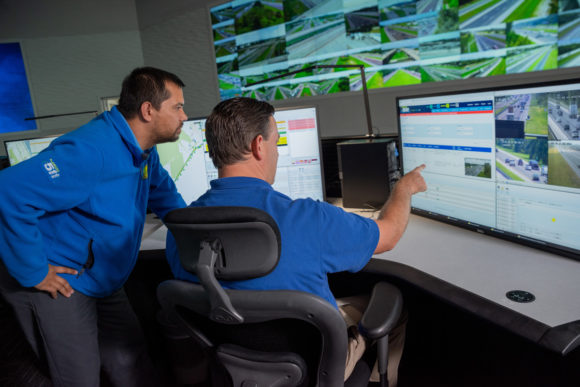
Using traffic cameras and data collected from sensors, operators respond to incidents quickly to dispatch emergency response teams.
The RTMC plays several vital roles in improving public safety. They range from keeping traffic flowing on interstates to coordinating fast and safe responses to crashes on highways and many other major roads.
In times of crisis, the RTMC transforms into an emergency management center to help respond to storms and other disasters such as flooding and wildfires.
Built to withstand a Category 3 hurricane (winds up to 129 mph), the RTMC also has battery backups for its systems and a vast communication reach, making it a natural location for emergency managers to gather to coordinate preparation and response, and convey crucial messages to the public.
The Florida Highway Patrol manages a dispatch center in the building for many of its daily operations.
The building includes a kitchen and shower facilities in case conditions force managers and staff to remain inside the secure structure for several days.
If a storm forces an evacuation of parts of Florida, traffic managers can monitor specified evacuation routes via live feeds from roadside cameras and traffic sensors. They can also change the timing on traffic signals to ensure the best possible traffic flow during a crisis.
More incident management info
More emergency management info
Road Rangers
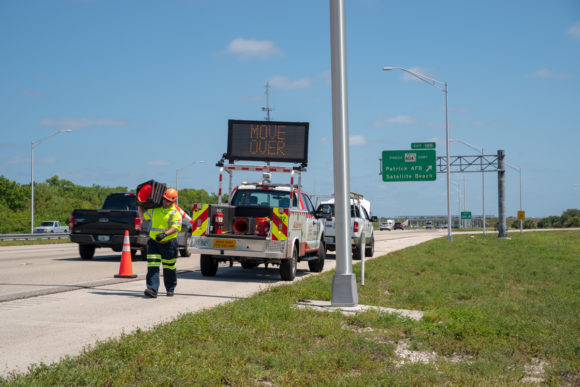
Road Rangers can be reached by dialing *347.
With hundreds of thousands of drivers rolling along Central Florida’s highways and major roadways every day, traffic incidents are bound to happen.
But what happens in the moments right after engine trouble or a flat tire can mean the difference between a minor inconvenience for one driver and a major traffic backup for thousands of others.
Fortunately, some of the most heavily traveled roads in Central Florida receive help from the dauntless safety and service patrols known as the Road Rangers.
With their well-stocked roadside-assistance trucks, the Road Rangers, which provide incident management response services, are problem solvers, troubleshooters and occasional lifesavers, shielding incident scenes and stranded motorists from dangerous highway traffic.
They can render a number of services for free, including changing a tire, providing gas, making minor mechanical repairs, and moving a disabled vehicle to a safe spot. By quickly getting motorists and their disabled vehicles out of harm’s way, Road Rangers help keep traffic flowing and minimize the risk of setting off a chain of crashes.
Road Rangers are just a phone call away at *347 (*FHP). In FDOT’s District Five, those calls for assistance and the subsequent directing of Road Rangers to motorists in need are handled by the Florida Highway Patrol dispatchers at the Regional Transportation Management Center.
Truck Parking Availability System
Central Florida’s interstate highways – Interstate 4 (I-4), I-75, and I-95 – handle nearly 40,000 commercial trucks each day.
FDOT helps truck drivers by letting them know about available parking at rest areas or weigh stations on the road ahead.
FDOT’s Truck Parking Availability System (TPAS) provides real-time information about available parking spaces, relaying that information to dynamic message signs located several miles ahead of a rest area or weigh station. The information is also available through Florida’s 511 Traveler Information System.
More info about Road Rangers
More information about truck parking availability









